2014 MITSUBISHI OUTLANDER SPORT air condition
[x] Cancel search: air conditionPage 248 of 388
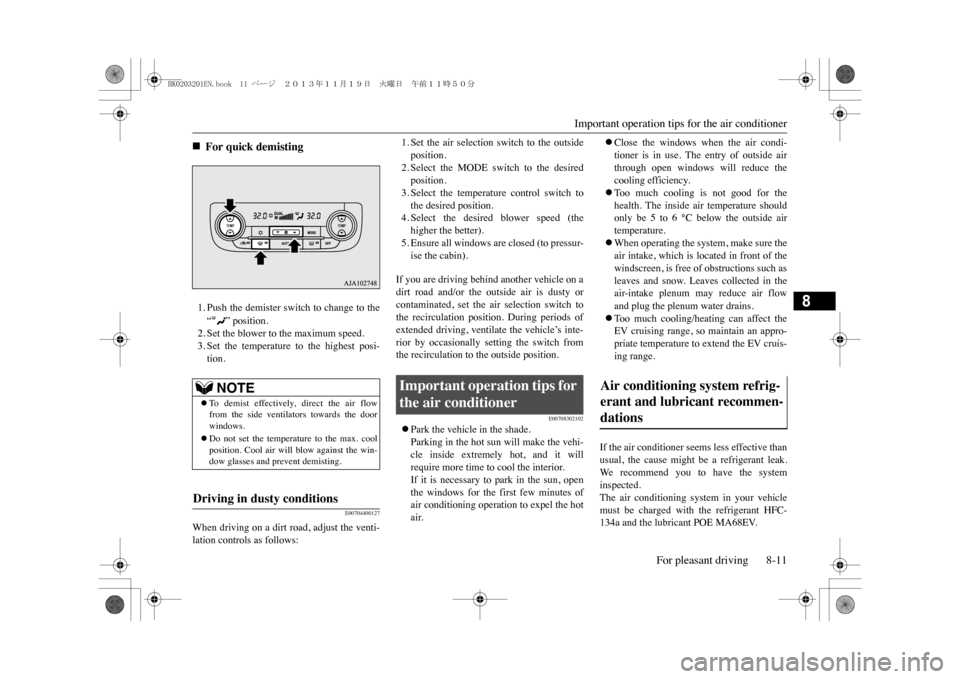
Important operation tips for the air conditioner
For pleasant driving 8-11
8
1. Push the demister switch to change to the“” position.2. Set the blower to the maximum speed.3. Set the temperature to the highest posi-tion.
E00704400127
When driving on a dirt road, adjust the venti-lation controls as follows:
1. Set the air selection switch to the outsideposition.2. Select the MODE switch to the desiredposition.3. Select the temperature control switch tothe desired position.4. Select the desired blower speed (thehigher the better).5. Ensure all windows are closed (to pressur-ise the cabin).
If you are driving behind another vehicle on adirt road and/or the outside air is dusty orcontaminated, set the air selection switch tothe recirculation position. During periods ofextended driving, ventilate the vehicle’s inte-rior by occasionally setting the switch fromthe recirculation to the outside position.
E00708302102
�zPark the vehicle in the shade.Parking in the hot sun will make the vehi-cle inside extremely hot, and it willrequire more time to cool the interior.If it is necessary to park in the sun, openthe windows for the first few minutes ofair conditioning operation to expel the hotair.
�zClose the windows when the air condi-tioner is in use. The entry of outside airthrough open windows will reduce thecooling efficiency.�zTo o m u c h c o o l i n g i s n o t g o o d f o r t h ehealth. The inside air temperature shouldonly be 5 to 6 °C below the outside airtemperature.�zWhen operating the system, make sure theair intake, which is located in front of thewindscreen, is free of obstructions such asleaves and snow. Leaves collected in theair-intake plenum may reduce air flowand plug the plenum water drains.�zTo o m u c h c o o l i n g / h e a t i n g c a n a f f e c t t h eEV cruising range, so maintain an appro-priate temperature to extend the EV cruis-ing range.
If the air conditioner seems less effective thanusual, the cause might be a refrigerant leak.We r e c o m m e n d y o u t o h a v e t h e s y s t e minspected.The air conditioning system in your vehiclemust be charged with the refrigerant HFC-134a and the lubricant POE MA68EV.
�
Page 249 of 388
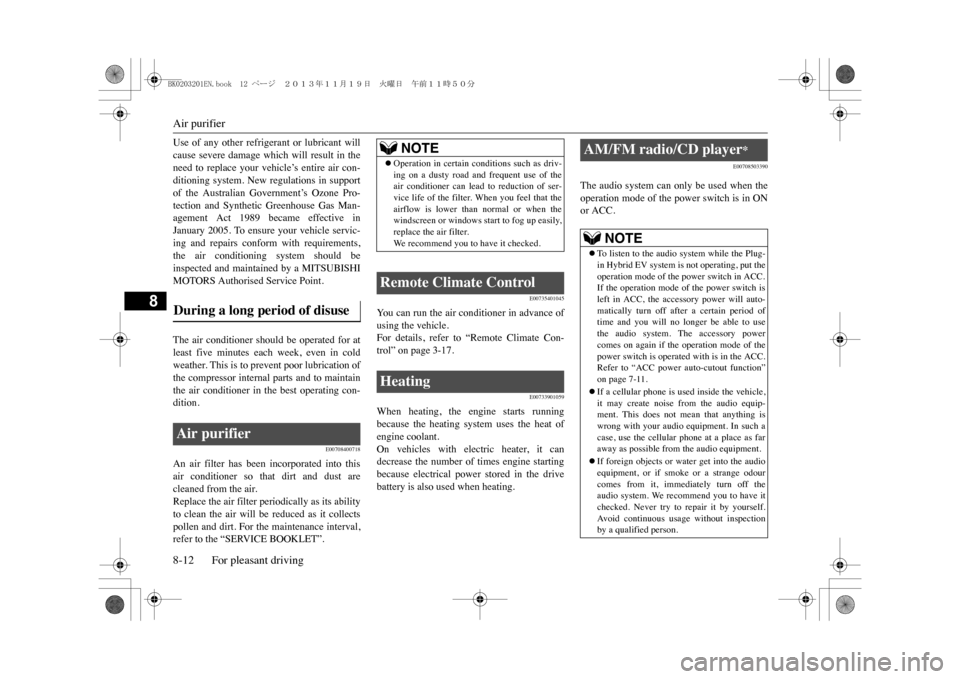
Air purifier8-12 For pleasant driving
8
Use of any other refrigerant or lubricant willcause severe damage which will result in theneed to replace your vehicle’s entire air con-ditioning system. New regulations in supportof the Australian Government’s Ozone Pro-tection and Synthetic Greenhouse Gas Man-agement Act 1989 became effective inJanuary 2005. To ensure your vehicle servic-ing and repairs conform with requirements,the air conditioning system should beinspected and maintained by a MITSUBISHIMOTORS Authorised Service Point.The air conditioner should be operated for atleast five minutes each week, even in coldweather. This is to prevent poor lubrication ofthe compressor internal parts and to maintainthe air conditioner in the best operating con-dition.
E00708400718
An air filter has been incorporated into thisair conditioner so that dirt and dust arecleaned from the air.Replace the air filter periodically as its abilityto clean the air will be reduced as it collectspollen and dirt. For the maintenance interval,refer to the “SERVICE BOOKLET”.
E00735401045
Yo u c a n r u n t h e a i r c o n d i t i o n e r i n a d v a n c e o fusing the vehicle.For details, refer to “Remote Climate Con-trol” on page 3-17.
E00733901059
When heating, the engine starts runningbecause the heating system uses the heat ofengine coolant.On vehicles with electric heater, it candecrease the number of times engine startingbecause electrical power stored in the drivebattery is also used when heating.
E00708503390
The audio system can only be used when theoperation mode of the power switch is in ONor ACC.
During a long period of disuse Air purifier
NOTE
�zOperation in certain c
onditions such as driv-
ing on a dusty road and frequent use of theair conditioner can lead to reduction of ser-vice life of the filter. When you feel that theairflow is lower than normal or when thewindscreen or windows start to fog up easily,replace the air filter.We r e c o m m e n d y o u t o h a v e i t c h e c k e d .
Remote Climate Control Heating
AM/FM radio/CD player
*
NOTE
�zTo l i s t e n t o t h e a u d i o s y s t e m w h i l e t h e P l u g -in Hybrid EV system is
not operating, put the
operation mode of the power switch in ACC.If the operation mode of the power switch isleft in ACC, the accessory power will auto-matically turn off after a certain period oftime and you will no longer be able to usethe audio system. The accessory powercomes on again if the operation mode of thepower switch is operated with is in the ACC.Refer to “ACC power auto-cutout function”on page 7-11.�zIf a cellular phone is used inside the vehicle,it may create noise from the audio equip-ment. This does not mean that anything iswrong with your audio equipment. In such acase, use the cellular phone at a place as faraway as possible from the audio equipment.�zIf foreign objects or wate
r get into the audio
equipment, or if smoke or a strange odourcomes from it, immediately turn off theaudio system. We recommend you to have itchecked. Never try to repair it by yourself.Av o i d c o n t i n u o u s u s a g e w i t h o u t i n s p e c t i o nby a qualified person.
BK0203201EN.book 12 ページ 2013年11月19日 火曜日 午前11時50分
Page 320 of 388
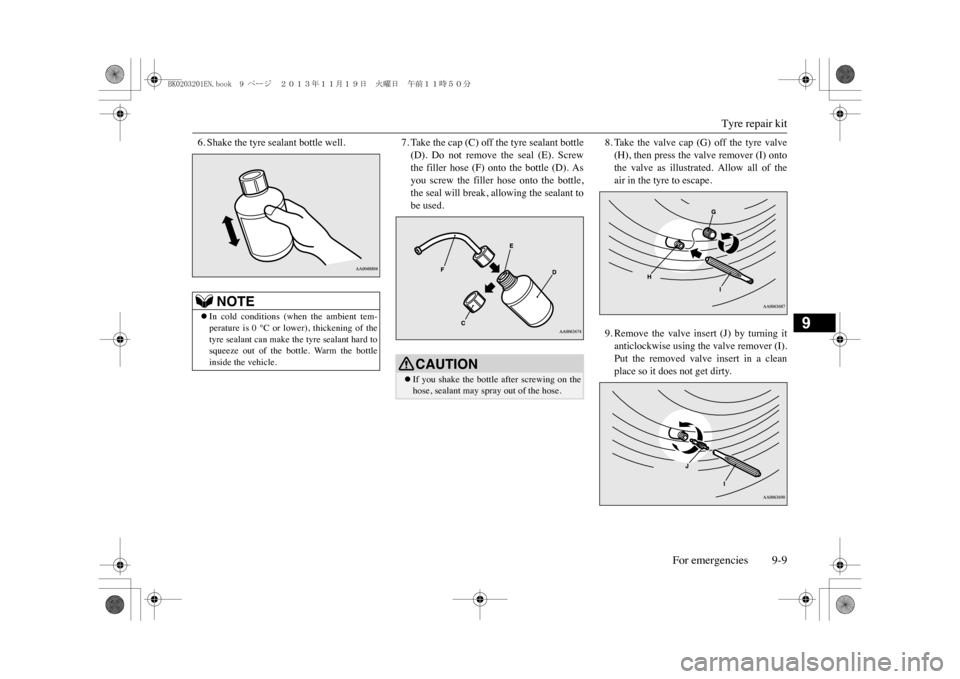
Tyre repair kit
For emergencies 9-9
9
6. Shake the tyre sealant bottle well.
7. Take the cap (C) off the tyre sealant bottle(D). Do not remove the seal (E). Screwthe filler hose (F) onto the bottle (D). Asyou screw the filler hose onto the bottle,the seal will break, allowing the sealant tobe used.
8. Take the valve cap (G) off the tyre valve(H), then press the valve remover (I) ontothe valve as illustrated. Allow all of theair in the tyre to escape.9. Remove the valve insert (J) by turning itanticlockwise using the valve remover (I).Put the removed valve insert in a cleanplace so it does not get dirty.
NOTE
�zIn cold conditions (when the ambient tem-perature is 0 °C or lo
wer), thickening of the
tyre sealant can make th
e tyre sealant hard to
squeeze out of the bottle. Warm the bottleinside the vehicle.
CAUTION�zIf you shake the bottle after screwing on thehose, sealant may spray out of the hose.
BK0203201EN.book 9 ページ 2013年11月19日 火曜日 午前11時50分
Page 324 of 388
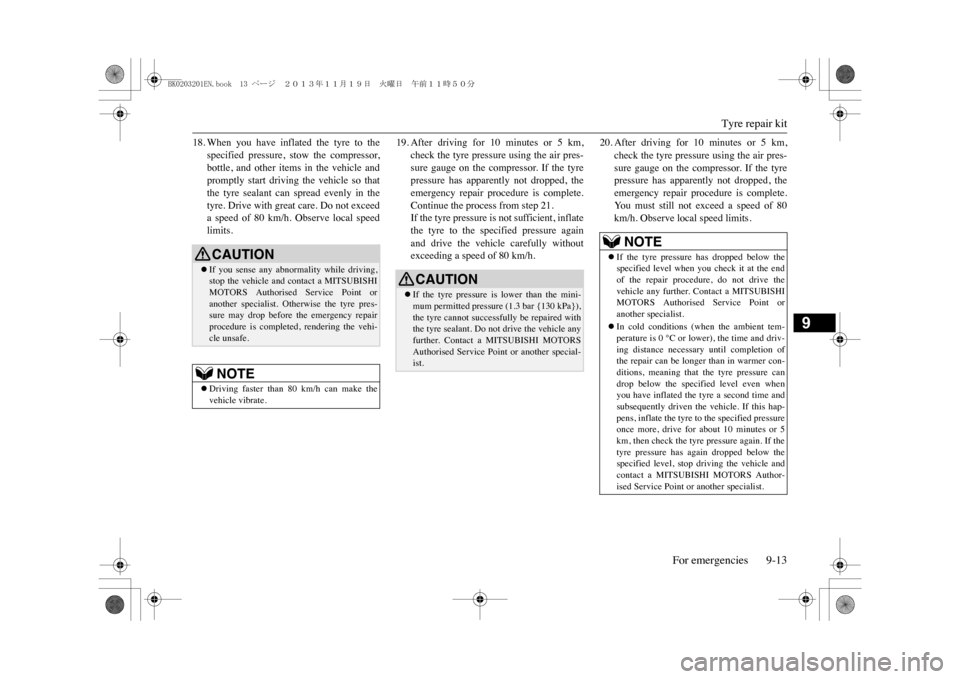
Tyre repair kit
For emergencies 9-13
9
18. When you have inflated the tyre to the
specified pressure, stow the compressor,bottle, and other items in the vehicle andpromptly start driving the vehicle so thatthe tyre sealant can spread evenly in thetyre. Drive with great care. Do not exceeda speed of 80 km/h. Observe local speedlimits.
19. After driving for 10 minutes or 5 km,
check the tyre pressure using the air pres-sure gauge on the compressor. If the tyrepressure has apparently not dropped, theemergency repair procedure is complete.Continue the process from step 21.If the tyre pressure is not sufficient, inflatethe tyre to the specified pressure againand drive the vehicle carefully withoutexceeding a speed of 80 km/h.
20. After driving for 10 minutes or 5 km,
check the tyre pressure using the air pres-sure gauge on the compressor. If the tyrepressure has apparently not dropped, theemergency repair procedure is complete.You must still not exceed a speed of 80km/h. Observe local speed limits.
CAUTION�zIf you sense any abnormality while driving,stop the vehicle and contact a MITSUBISHIMOTORS Authorised Service Point oranother specialist. Otherwise the tyre pres-sure may drop before the emergency repairprocedure is completed, rendering the vehi-cle unsafe.NOTE
�zDriving faster than 80 km/h can make thevehicle vibrate.
CAUTION�zIf the tyre pressure is lower than the mini-mum permitted pressure (1.3 bar {130 kPa}),the tyre cannot successf
ully be repaired with
the tyre sealant. Do not drive the vehicle anyfurther. Contact a MITSUBISHI MOTORSAuthorised Service Point or another special-ist.
NOTE
�zIf the tyre pressure has dropped below thespecified level when you check it at the endof the repair procedure, do not drive thevehicle any further. Contact a MITSUBISHIMOTORS Authorised Service Point oranother specialist.�zIn cold conditions (w
hen the ambient tem-
perature is 0 °C or lower), the time and driv-ing distance necessary until completion ofthe repair can be longer than in warmer con-ditions, meaning that the tyre pressure candrop below the specified level even whenyou have inflated the tyre a second time andsubsequently driven th
e vehicle. If this hap-
pens, inflate the tyre to the specified pressureonce more, drive for about 10 minutes or 5km, then check the tyre pressure again. If thetyre pressure has ag
ain dropped below the
specified level, stop dr
iving the vehicle and
contact a MITSUBISHI MOTORS Author-ised Service Point or another specialist.
BK0203201EN.book 13 ページ 2013年11月19日 火曜日 午前11時50分
Page 351 of 388
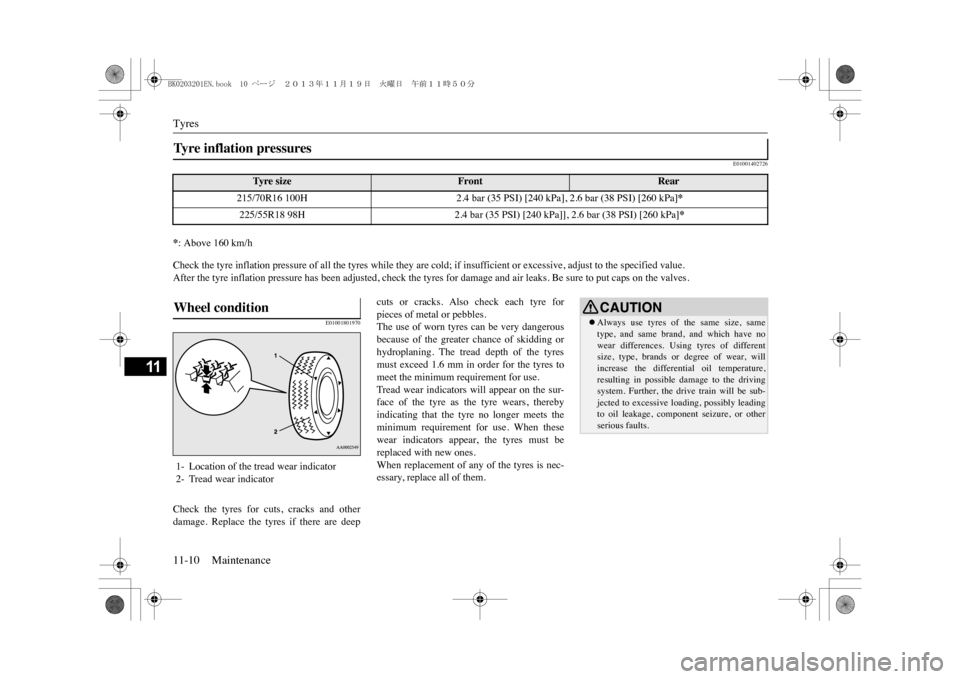
Tyres11-10 Maintenance
11
E01001402726
*: Above 160 km/hCheck the tyre inflation pressure of all the tyres while they ar
e cold; if insufficient or excessive, adjust to the specified v
alue.
After the tyre inflation pressure has been adjusted, check the tyres for damage and air leaks. Be sure to put caps on the valve
s.
E01001801970
Check the tyres for cuts, cracks and otherdamage. Replace the tyres if there are deep
cuts or cracks. Also check each tyre forpieces of metal or pebbles.The use of worn tyres can be very dangerousbecause of the greater chance of skidding orhydroplaning. The tread depth of the tyresmust exceed 1.6 mm in order for the tyres tomeet the minimum requirement for use.Tread wear indicators will appear on the sur-face of the tyre as the tyre wears, therebyindicating that the tyre no longer meets theminimum requirement for use. When thesewear indicators appear, the tyres must bereplaced with new ones.When replacement of any of the tyres is nec-essary, replace all of them.
Ty r e i n f l a t i o n p r e s s u r e s
Ty re s i z e
Front
Rear
215/70R16 100H
2.4 bar (35 PSI) [240 kPa], 2.6 bar (38 PSI) [260 kPa]
*
225/55R18 98H
2.4 bar (35 PSI) [240 kPa]], 2.6 bar (38 PSI) [260 kPa]
*
Wheel condition 1- Location of the tread wear indicator2- Tread wear indicator
CAUTION�zAlways use tyres of the same size, sametype, and same brand, and which have nowear differences. Using tyres of differentsize, type, brands or
degree of wear, will
increase the differential oil temperature,resulting in possible damage to the drivingsystem. Further, the drive train will be sub-jected to excessive loading, possibly leadingto oil leakage, component seizure, or otherserious faults.
BK0203201EN.book 10 ページ 2013年11月19日 火曜日 午前11時50分
Page 359 of 388
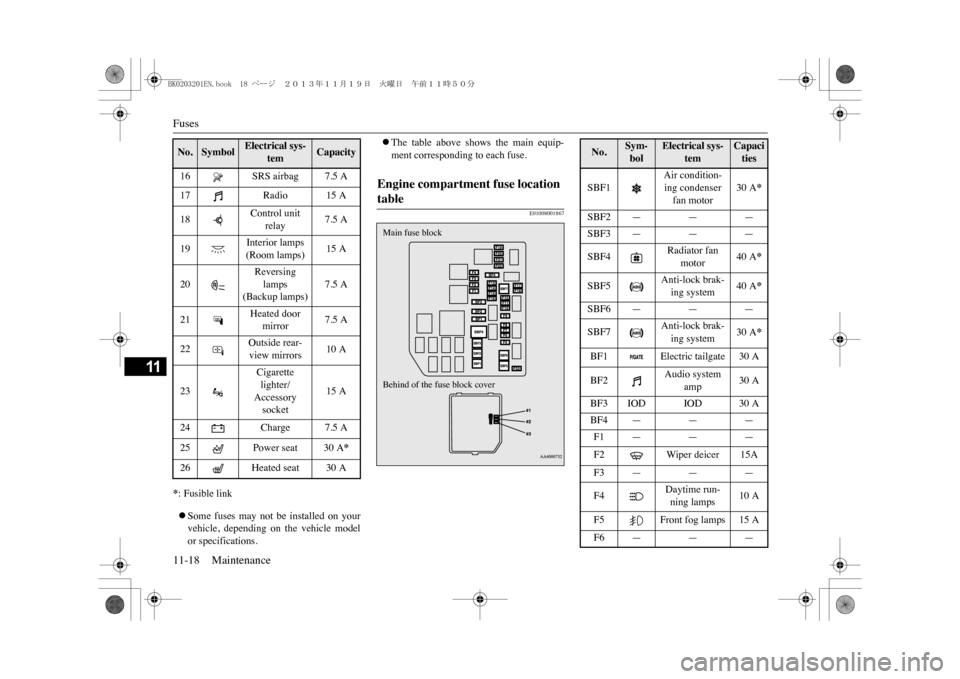
Fuses11-18 Maintenance
11
*: Fusible link�zSome fuses may not be installed on yourvehicle, depending on the vehicle modelor specifications.
�zThe table above shows the main equip-ment corresponding to each fuse.
E01008001867
16
SRS airbag 7.5 A
17
Radio 15 A
18
Control unit
relay
7.5 A
19
Interior lamps(Room lamps)
15 A
20
Reversing lamps
(Backup lamps)
7.5 A
21
Heated door
mirror
7.5 A
22
Outside rear-view mirrors
10 A
23
Cigarette lighter/Accessory socket
15 A
24
Charge 7.5 A
25
Power seat 30 A
*
26
Heated seat 30 A
No.
Symbol
Electrical sys-
tem
Capacity
Engine compartment fuse location table Behind of the fuse block coverMain fuse block
No.
Sym-bol
Electrical sys-
tem
Capacities
SBF1
Air condition-ing condenser fan motor
30 A
*
SBF2 — — —SBF3 — — —SBF4
Radiator fan
motor
40 A
*
SBF5
Anti-lock brak-ing system
40 A
*
SBF6 — — —SBF7
Anti-lock brak-ing system
30 A
*
BF1
Electric tailgate 30 A
BF2
Audio system
amp
30 A
BF3 IOD IOD 30 ABF4 — — —F1 — — —F2
Wiper deicer 15A
F3 — — —F4
Daytime run-ning lamps
10 A
F5
Front fog lamps 15 A
F6 — — —
BK0203201EN.book 18 ページ 2013年11月19日 火曜日 午前11時50分
Page 361 of 388
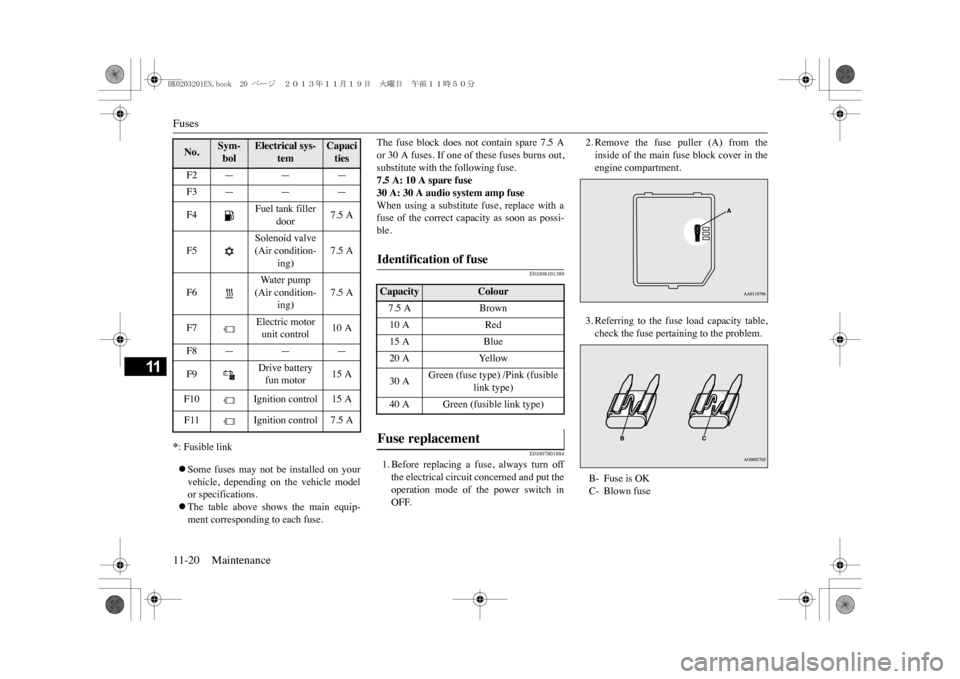
Fuses11-20 Maintenance
11
*: Fusible link�zSome fuses may not be installed on yourvehicle, depending on the vehicle modelor specifications.�zThe table above shows the main equip-ment corresponding to each fuse.
The fuse block does not contain spare 7.5 Aor 30 A fuses. If one of these fuses burns out,substitute with the following fuse.7.5 A: 10 A spare fuse30 A: 30 A audio system amp fuseWhen using a substitute fuse, replace with afuse of the correct capacity as soon as possi-ble.
E01008101389E01007801884
1. Before replacing a fuse, always turn offthe electrical circuit concerned and put theoperation mode of the power switch inOFF.
2. Remove the fuse puller (A) from theinside of the main fuse block cover in theengine compartment.3. Referring to the fuse load capacity table,check the fuse pertaining to the problem.
F2 — — —F3 — — —F4
Fuel tank filler
door
7.5 A
F5
Solenoid valve (Air condition-
ing)
7.5 A
F6
Wa t e r p u m p (Air condition-
ing)
7.5 A
F7
Electric motor unit control
10 A
F8 — — —F9
Drive battery fun motor
15 A
F10
Ignition control 15 A
F11
Ignition control 7.5 A
No.
Sym-bol
Electrical sys-
tem
Capacities
Identification of fuse Capacity
Colour
7.5 A
Brown
10 A
Red
15 A
Blue
20 A
Ye l l o w
30 A
Green (fuse type) /Pink (fusible
link type)
40 A Green (fusible link type)
Fuse replacement
B- Fuse is OKC- Blown fuse
BK0203201EN.book 20 ページ 2013年11月19日 火曜日 午前11時50分
Page 380 of 388
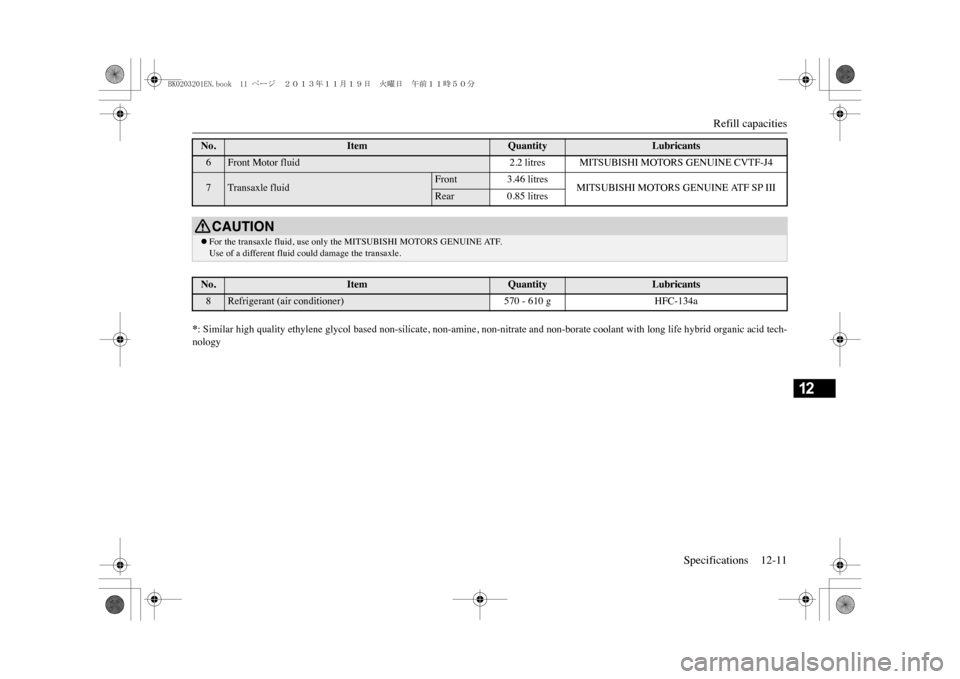
Refill capacities
Specifications 12-11
12
*: Similar high quality ethylene glycol based non-silicate, non-amine, non-nitrate and non-borate coolant with long life hybrid
organic acid tech-
nology
6
Front Motor fluid
2.2 litres MITSUBISHI MOTORS GENUINE CVTF-J4
7
Transaxle fluid
Front 3.46 litres
MITSUBISHI MOTORS GENUINE ATF SP III
Rear
0.85 litres
CAUTION�zFor the transaxle fluid, use only th
e MITSUBISHI MOTORS GENUINE ATF.
Use of a different fluid could damage the transaxle.No.
Item
Quantity
Lubricants
8
Refrigerant (air conditioner)
570 - 610 g
HFC-134a
No.
Item
Quantity
Lubricants
BK0203201EN.book 11 ページ 2013年11月19日 火曜日 午前11時50分